Tactical Analysis: Roger Schmidt’s Benfica
Since leaving PSV in the summer of 2022, Roger Schmidt has settled in at a different red & (somewhat) white club, none other than Benfica. The German has led ‘As Aguias’ to a Portuguese title and a Supercup in only one and a half years at the capital club. It has been a difficult run of form for Benfica, who lost 2-1 to Sporting in the first leg of the Taca de Portugal semifinals before suffering a humiliating 5-0 loss to Porto, their first league defeat since opening day. Benfica trail Sporting by a point, with Ruben Amorim’s side having a game in hand, and they have 10 matches to make up the distance as they look to successfully defend their league title.
On paper, Benfica line-up in a 4–2–3–1 formation, with many new faces since the 22/23 season. Spanish left-back Alex Grimaldo left the club on free to join Bayer Leverkusen, while youngster Goncalo Ramos exchanged the Portuguese capital for “La Ville Lumiere,” joining PSG. While two crucial players left, they have been since replaced perfectly by Morato, Arthur Cabral and co. Schmidt also likes to rotate the lineup as he has many multi-functional players, for example Fredrik Aursnes who can play in both of the wing back roles as well as in midfield.

As always, we will take a look at Benfica’s in-possession setup first. ‘Os Encarnados’ use principles of positional play in the first phase of build-up. When either of the fullbacks moves up the pitch, the other moves across to the defence and one of the midfielders drops deep to support the build-up.

Another recognisable pattern in the deep build-up is Benfica’s two center backs with two midfielders and the fullbacks wide higher up the pitch.

Then from this deep possession state, Benfica can build from a back three. One midfielder sits in front of the defence to support the build-up and progress play further up. After possession has progressed, one of the wide center backs will progress into either midfield or out wide.

While Benfica have some different deep build-up patterns it’s difficult to show them all. This is because Roger Schmidt -as mentioned before- uses many principles of positional play, which means their build-up pattern will differ from in-game situations.
When Benfica tries to move play up the pitch through the fullbacks they will either have the fullback progress the play by himself or the winger will drop deep to create a 1–2 or look for the third-man pass. The fullback will over or underlap the winger, this somewhat depends on the player that is at fullback.


As the play progresses, Benfica try to make sure most of their play takes place on their opponent’s half. The fullbacks are positioned out wide, while the wingers come inside to make space for the overlapping defender.

In this phase Angel Di Maria is Benfica’s not very well-kept secret as the Argentine has creative liberty and thus can run into space, or between the lines to create Benfica’s attacks and by doing this he makes Benfica’s attacks unpredictable and keeps opponents on their toes.
As Benfica approach their opponent’s goal, a few recognisable patterns can occur, but again due to Benfica’s usage of positional play and players’ relative freedom, these patterns don’t necessarily rule out any other pattern of attack. One of these patterns is when the ball is out wide, and could lead to a cross into the box. The three forwards group together closely and the fullback on the opposite side comes into midfield.
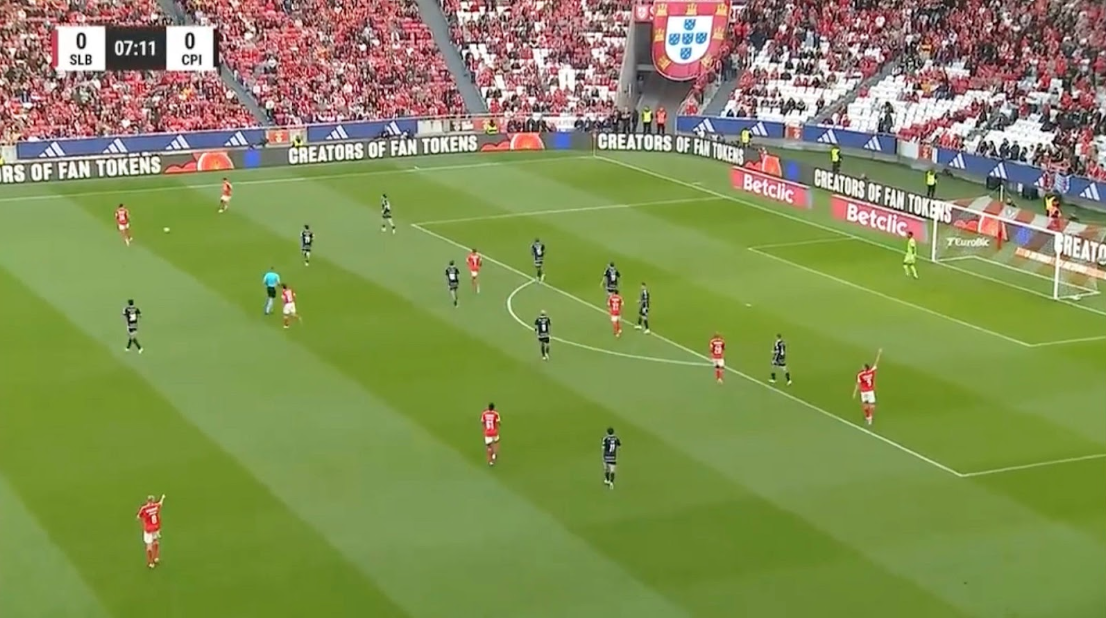
The other way Benfica create their attacks is having the ball near the middle of the pitch, and spacing out the opponent’s defence by having their wingers very wide and thus – most often Rafa Silva – can fill in the channel and then continue attacking. Or when one of the wingers drops deep, Silva will come across to fill in for him and create a triangle.
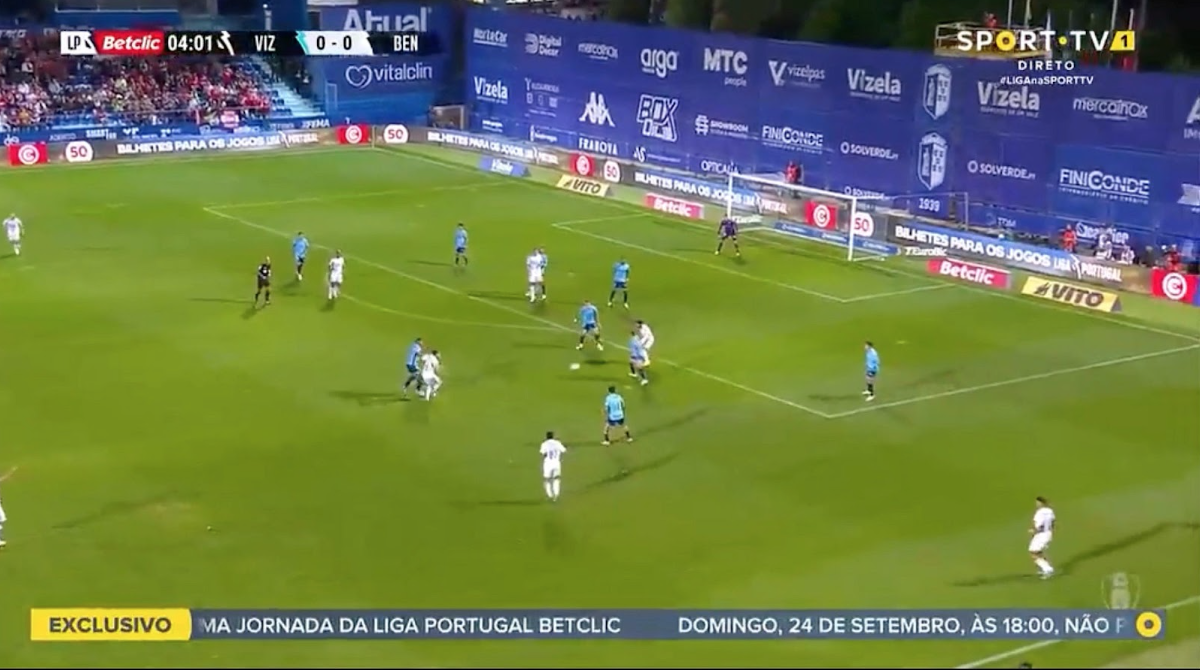

Out of possession, Benfica is all about aggressive pressing high up the pitch. This happens in a 4–4–2 formation as the attacking midfielder steps up next to the striker, and the wingers drop deeper towards the midfield.
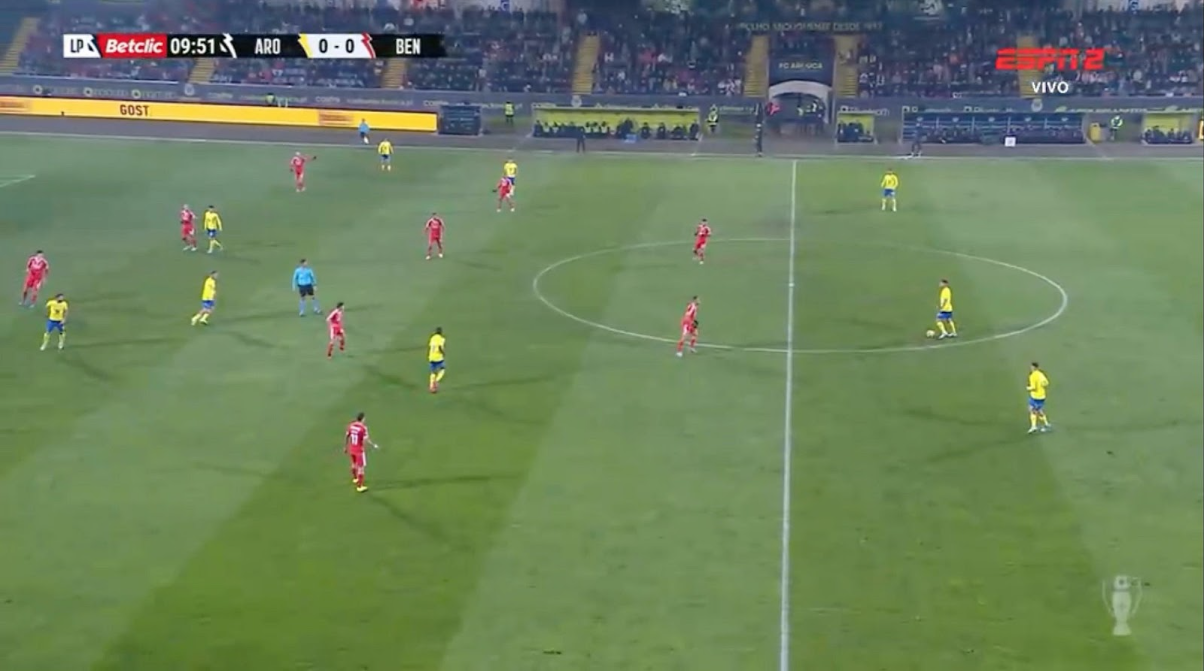
The now two strikers attach themselves to a centre back each as Rafa presses the on-the-ball CB and forces the ball to the fullback, then the winger and a midfielder can close him down while using the sideline as an extra defender.
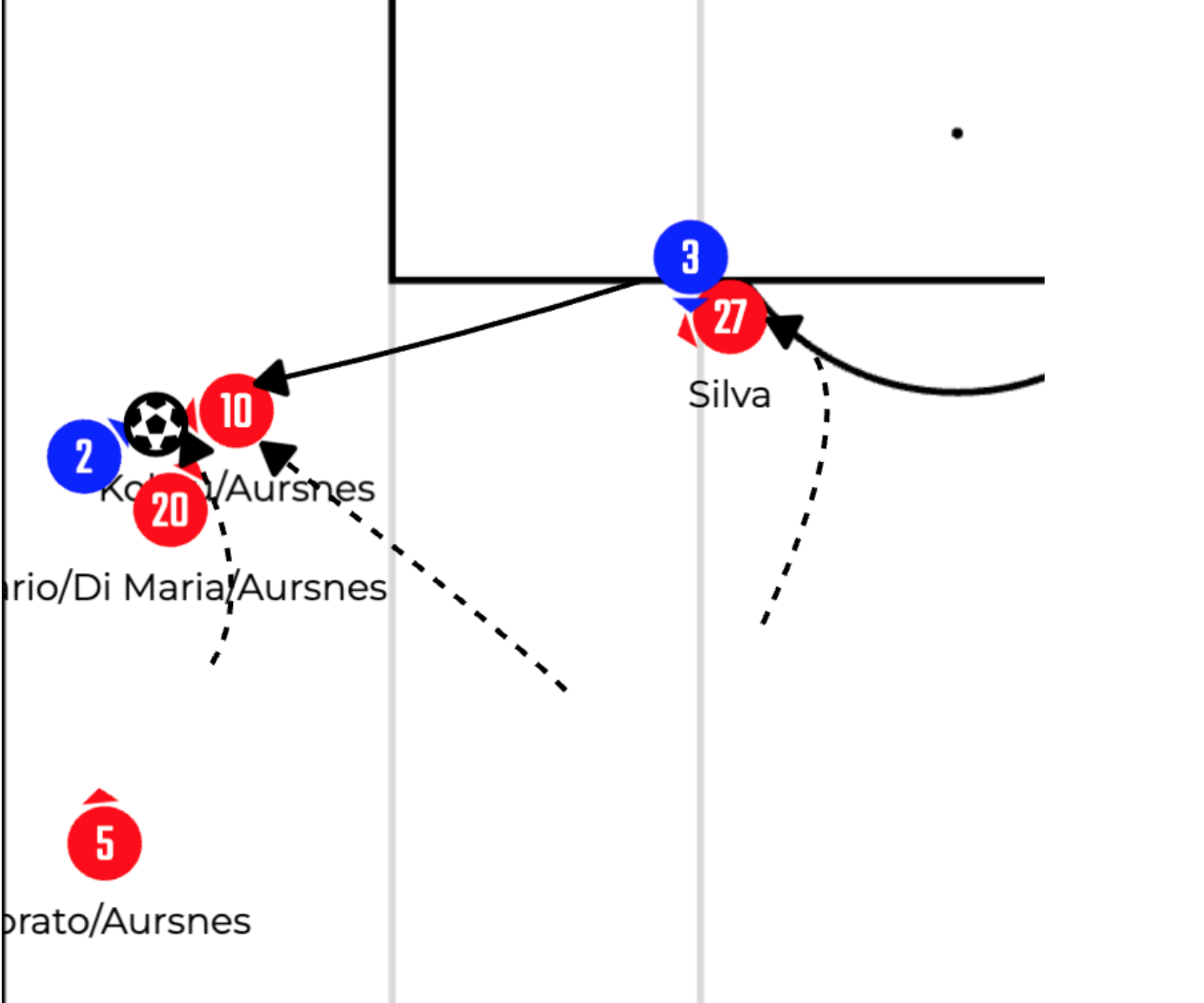
Benfica press with a clear intention of winning the ball back and quickly attacking with it. If Benfica’s opponents get past the halfway line, Benfica drop in slightly more, but still try to force the ball outwards by staying in the compact 4–4–2 shape. This of course has multiple reasons. First of all, a ball out wide is drastically less dangerous than a ball around the midfield, and near the sideline Benfica can utilise the same pressing pattern as shown in image 12, thus winning the ball back and being able to counter quickly. This approach gives Benfica the upper hand even out of possession, but considering the pure quality of their players the capital club most often has the upper hand no matter what.
And below, is the Benfica set-piece analysis from Harry, better known as TheSpursScout . With a squad that has the likes of Nicolas Otamendi and Angel di Maria, Benfica possesses serious quality when it comes to corners both defensively and offensively. Let’s have a look at them defensively first though. How they set up, why and how well they cope.
Benfica deploy a hybrid system regardless of how the opposition set up, with five players given zonal responsibilities along the six yard line with usually 2-3, depending on how many players the opposition players commit, positioned roughly around the penalty spot. Schmidt like many other coaches places his two CBs centrally, usually being Otamendi and Silva but Morato will come in from time to time and it’s not out of the blue to see all three on the pitch at the same time with Morato being deployed as LB, which also gives the Portuguese giants extra security defensively from corners.
Eight years ago, Benfica signed Alex Grimaldo, a promising 20-year-old Spanish left back who was unable to break into Barcelona’s first team.
Grimaldo proceeded to score 27 goals and 66 assists in 303 appearances and win four league titles before departing in the summer of 2023. pic.twitter.com/8kJHimZKUz
— Breaking The Lines (@BTLvid) February 15, 2024
Either side of the two CBs is Alexander Bah religiously found at the back post with Joao Neves taking front post responsibility on the corner of the six yard box. Neves is a super interesting player to give this level of responsibility to. Neves is one of Benfica’s smallest players standing at 178cm/5ft8, yet in my opinion has some of the best ability aerially in the entire squad possessing a tremendous explosive leap as well as being fairly strong in contact when in the air. His heading is also good clearing a good distance with clean contact.
You could say it’s Benfica’s secret weapon, baiting the kicker to look to hit the front post. Neves this season is averaging 1.85 aerials won p90, which puts himself in the 86th percentile of players in the same position across the worlds top 14 leagues. This is an open play stat however this helps give a better picture of how effective he is when the ball is up in the air and to be won.
The man to man players vary depending on lineup, but usually it’s the Benfica’s midfielders taking this role. With one winger being on the edge of the box to stop the short corner, and one on the edge to close down any shots from clearances or to start counter attacks. The image below is the best example to show Benfica’s shape.

Benfica are strong defensively from corners. The trifecta of Otamendi, Silva and Ukraine international Anatoliy Trubin in goal, corners that are hit into the central are of the goal are dealt with too good affecting whether that being a commanding claim from Trubin or a thumping header from Otamendi or Silva.
Their biggest weakness, however, is with the man to man markers, in and around the penalty spot. The midfielders that usually take up this area and role are; Orkun Kökçu, Joao Mario, Fredrik Aursnses or Florentino Luis, 4 players who aren’t incapable athletes physically yet seem to be weak and too attack minded when it comes to marking.
Aursnes is particularly weak and vulnerable to being manipulated easy by opposition attackers, whilst Joao Mario is prone to ball watching and thinking too far ahead and starting his movement forward to support a counter attack when the ball has just been crossed in allowing for free runs from attackers. Benfica could do with a lot of fixing in this area as more often than not, CBs are being allowed to easily and quickly gain separation to pick up momentum to attack crosses against defenders that are having to statically jump in their zone.
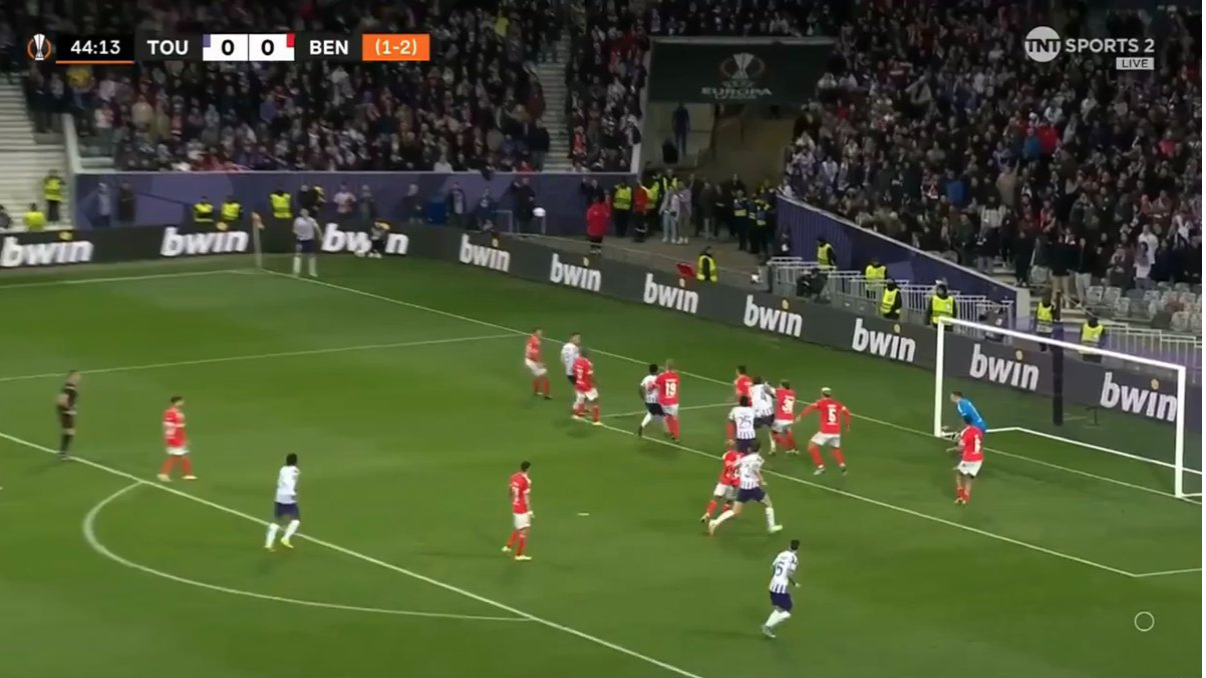
Here’s an example of Joao Mario allowing a completely free run with ease, on his blindside. The delivery went through all the way and Rasmus Nicolaisen was inches away from making connection with the ball and scoring.
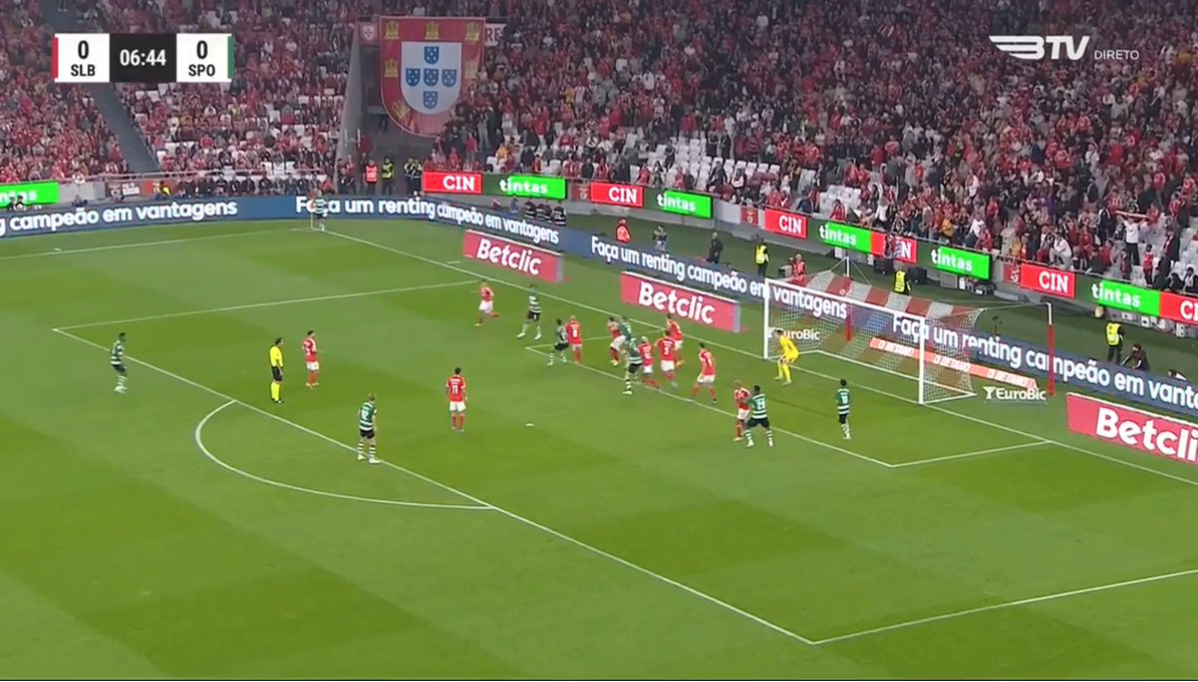
In this example, we see an in-swinger from Pedro Goncalves where Sporting have look to send players to the front post in potential aim for a flick on to the back post where Mario is left 2v1. And even here in a high risk situation, Mario takes a step ahead of Ousmane Diomande meaning his body weight is naturally going forward and away from the CB and the goal. Fortunately for Mario and Benfica, the corner was dealt with at the front post otherwise if it found its way to the back post Sporting had an easy tap in. Sporting found quite a lot of success by attacking the back post vs Benfica, something that combines all of Benfica’s weaknesses when defending corners in one.
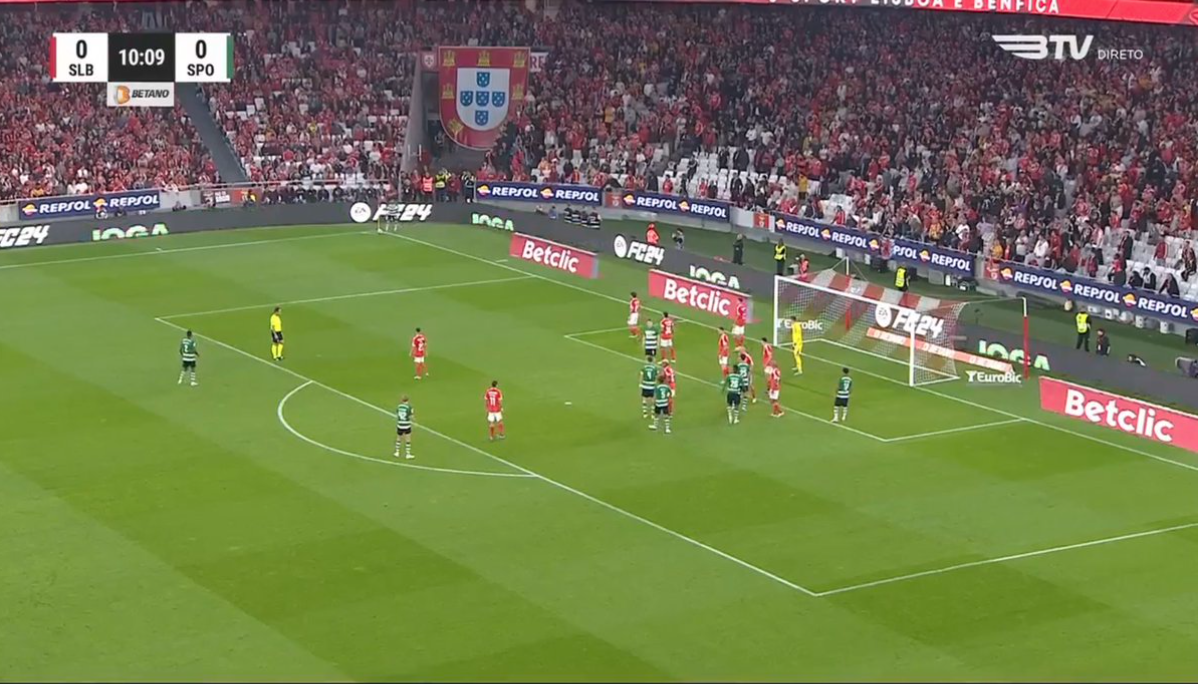
Sporting start slightly higher offensively with their positioning. Sporting CBs come with a +1, Hidemasa Morita positioned behind Sebastian Coates and Diomande behind Goncalo Inacio. Inacio and Coates go to the front post, which creates an overload at the back post. 6v3 in favour of Benfica at the front 3v2 in favour of Sporting at the back, and that’s where the cross is hit.
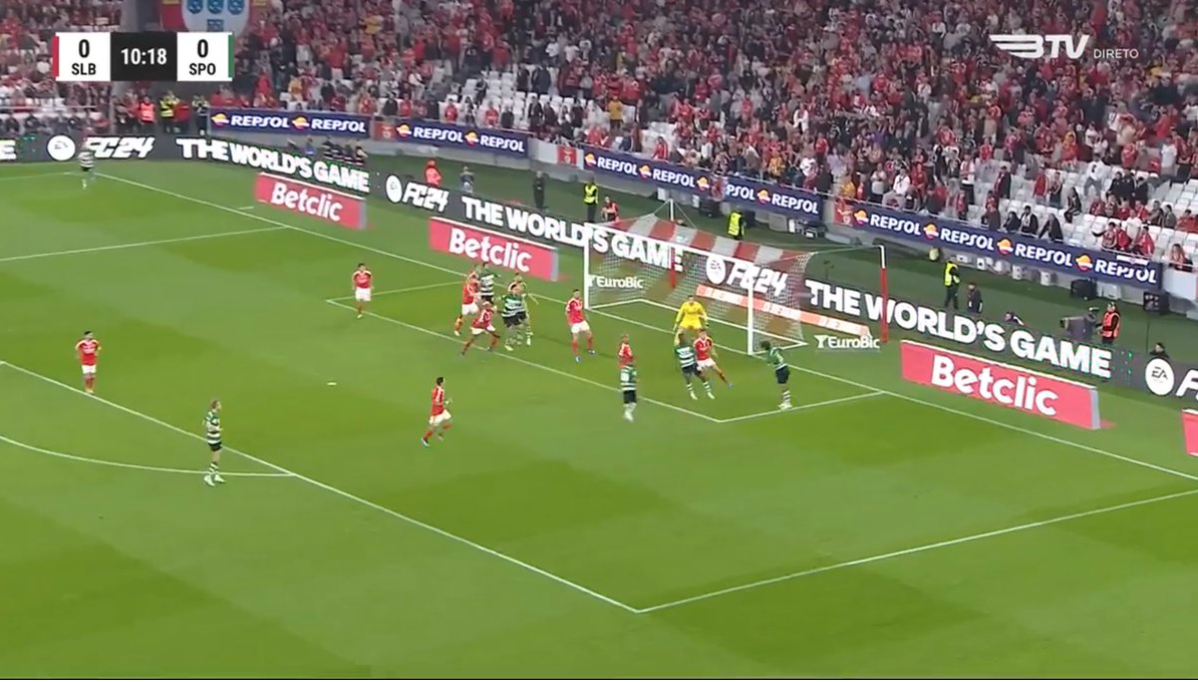
The cross is slightly deeper than what Morita would want, but he looks to head back across to the front post where Sporting’s most dangerous players are – Viktor Gyokeres, Coates, Inacio – with no one even close to competing with the Japanese midfielder. Fortunately for Benfica the header is poor and Morato heads away. But this is Benfica’s kryptonite. The over-emphasis with front post positioning as well as poor man markers allows for their structure to be easily manipulated for attacking teams to create the chances they want to create
From attacking corners, Benfica have a powerful weapon and he goes by the name of Angel Di Maria and they try to maximise his wicked left foot as much as possible. The most effective delivery from corners nowadays is an inswinger to the front post, you see so many fail to ‘beat the first man’ and I am guilty of pulling my hair out at this sight, I watched Christian Eriksen hit the first man religiously for years on years however when the delivery is good, chaos ensues. Benfica set up to create that chaos and exploit all of Di Maria’s magic in his left foot.
Benfica 9 times out of 10 will have an in-swinging delivery, into the six yard box where it’s packed full of red shirts and depending on the corner taker will be distributed accordingly. Di Maria in swingers usually mean a heavy presence at the front post and Neves floating at the back post. Right footed deliveries from Neves lead to a more evenly distributed set up. When one of the most underrated footballers of our generation, Angel Di Maria steps up to swing the ball in.
This is the usual set up and sight. Benfica’s big boys get in the mixer with their attacking threats sitting ready to pounce on the edge of the box if the ball falls out to them. Within 8 yards of the goal Benfica commit Tomas Araujo (6ft2), Petar Musa (6ft4), Antonio Silva (6ft) and Nicolas Otamendi (6ft) not only do they have height, they have enough physical strength in terms of power and upper body strength to affect play even if they don’t win the header and that’s exactly what happened in this specific game vs RB Salzburg.
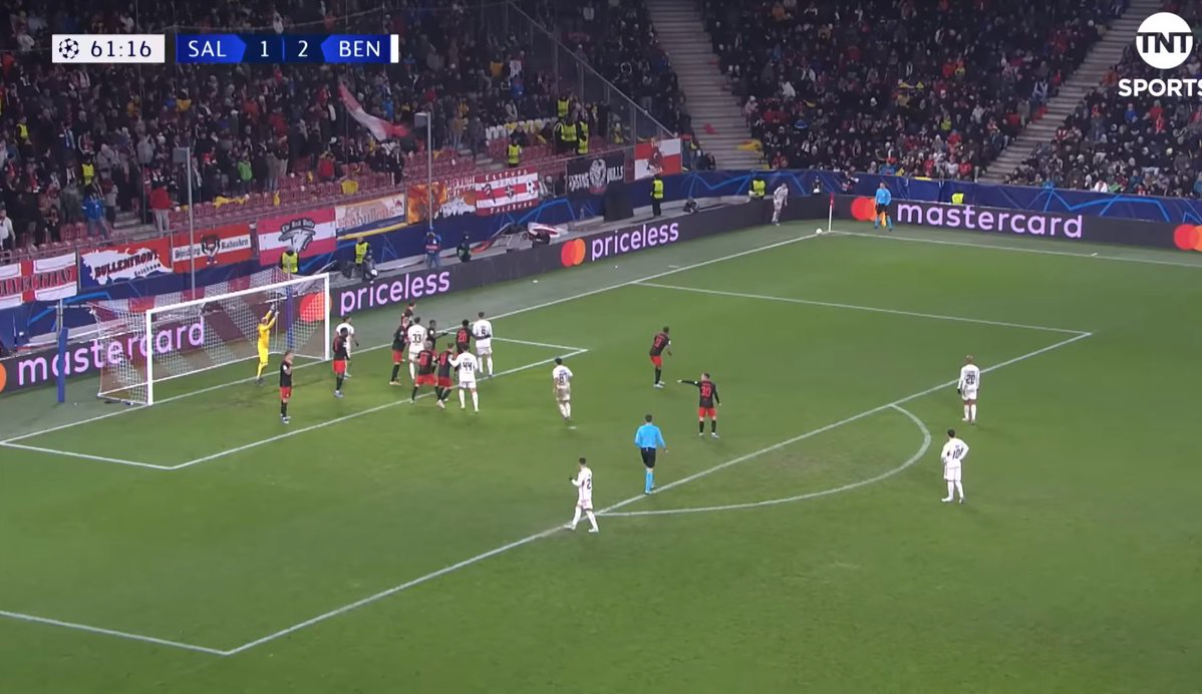
Di Maria can be a menace, he possesses an incredible technique with his crossing from dead ball scenarios that can be played at a fairly narrow and tight cross yet with tremendous amounts of curve and power and this is why you see Benfica pack out the front post.
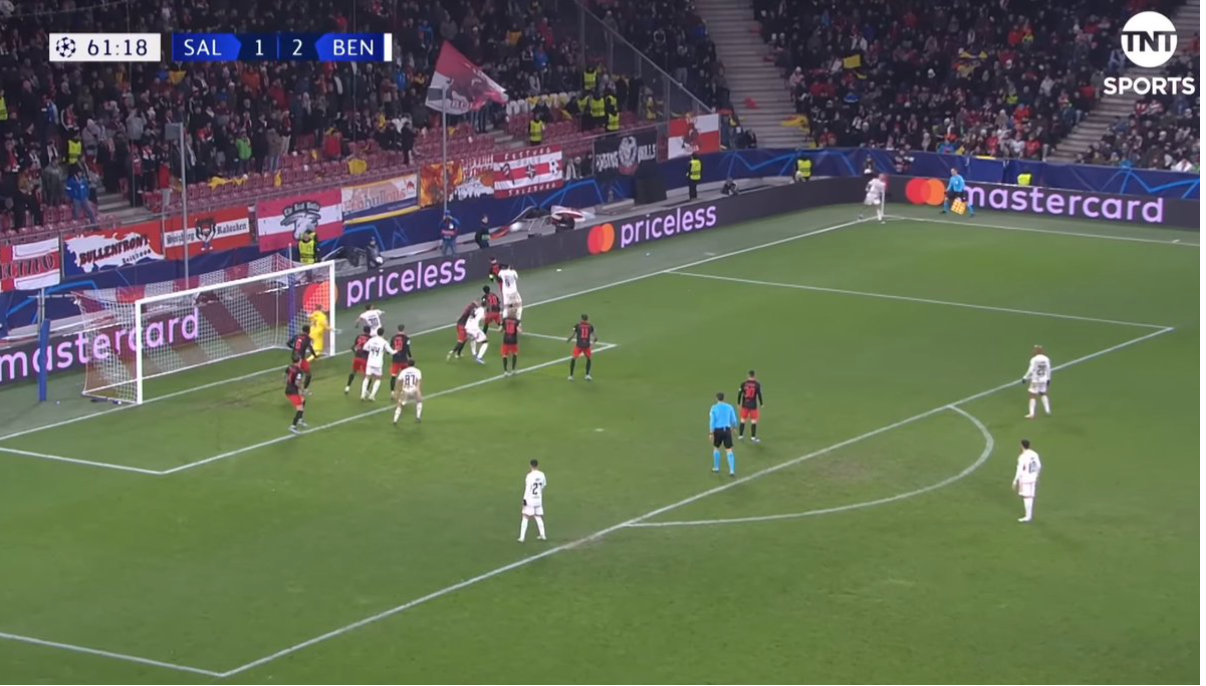
Silva goes to compete whilst Musa holds off the defender allowing Otamendi to be free at the front post who got a toe on it which resulted in the post being hit. Earlier in this game though is the best example of Di Maria’s ability from corners, where he scored directly from one to put the Eagles 1-0 up.
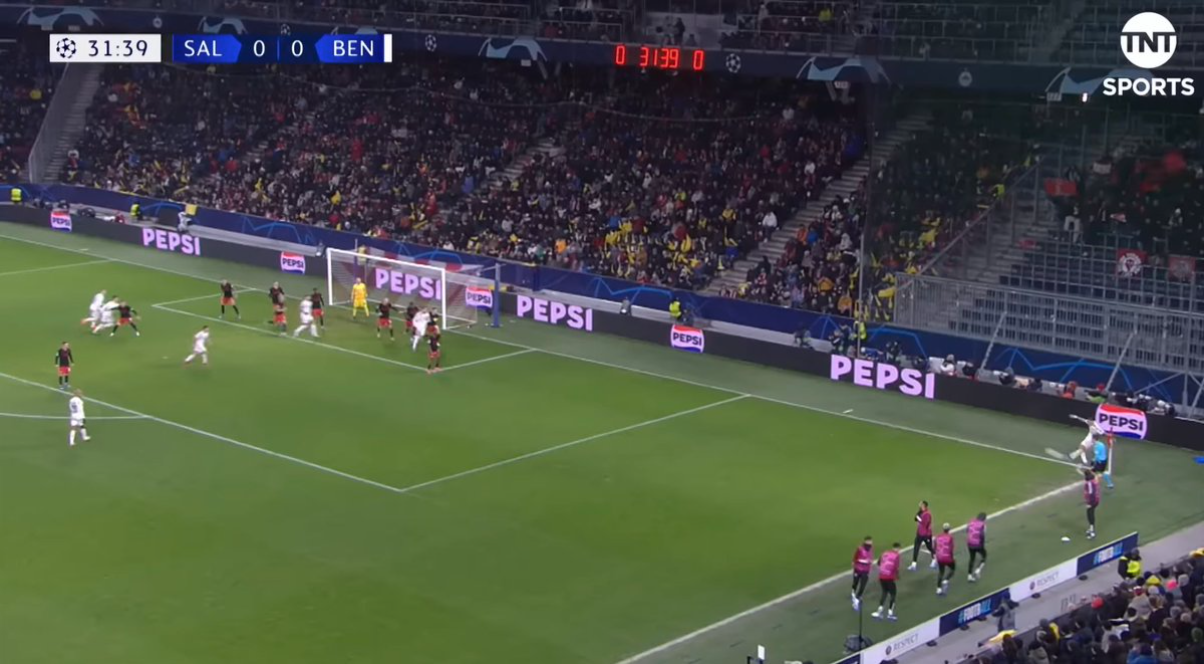
Musa goes towards Di Maria to open up space, allowing for Otamendi to squeeze in at the front post to block the Salzburg defenders from getting to the ball.

Two Benfica players lurking at the back post in case of any flick ons, however the ball hits the back of the net. Benfica 1-0 Salzburg. As easy as one, two, three.

On the opposite flank, Joao Neves takes corners and this is where you see a similar set up to the above image where Di Maria scores vs Salzburg.
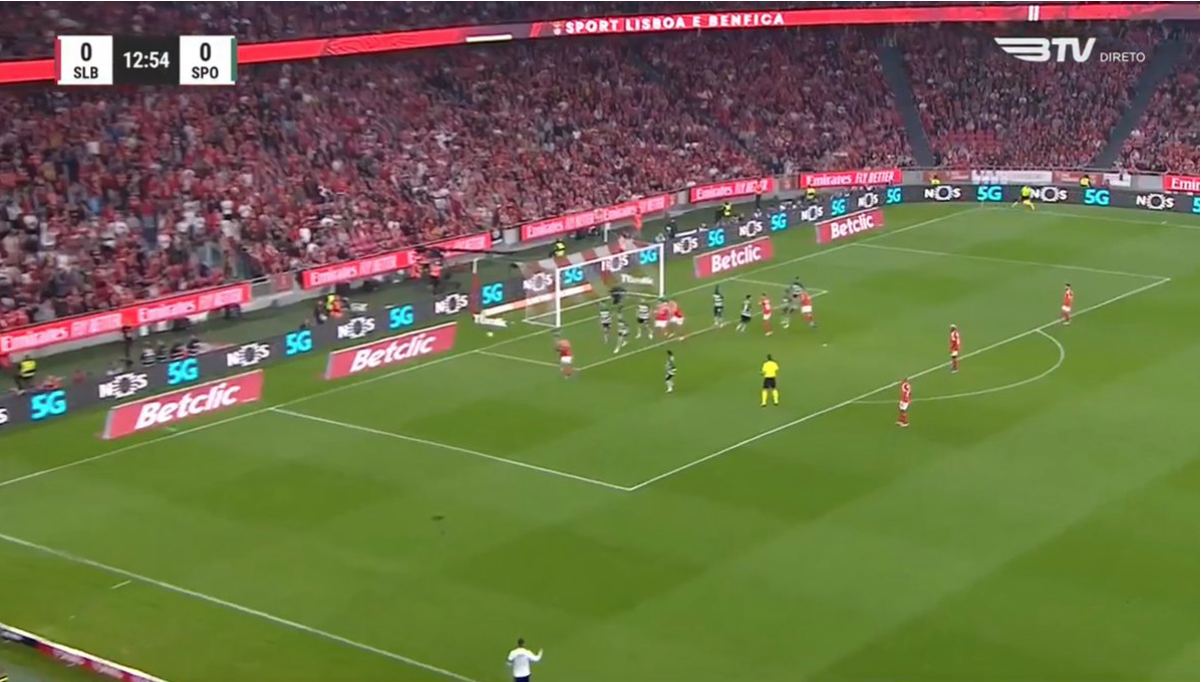
Neves here plays it in looking for Di Maria who drags forward to the ball looking to flick it on in the direction of either the two Benfica players centrally or at the back post, however Di Maria gets beaten in the air. However that is not a bad thing all together, with their set up around the box they’re able to easily sustain pressure on Benfica with Joao Mario able to create overloads out wide on the left, or if the ball runs deep (somehow) they have Rafa who will be able to manufacture a crossing opportunity more often than not, with Luis being a threat if that was the case as the defence are stepping up Luis will be heading in the opposition direction both in terms of his movement and actual action.
Benfica could add more variety to their corners going forward and actually take a low number of short corners for a team as dominant as they’re in Portugal. However with Di Maria something can always happen and the ever-growing Joao Neves it’s hard to completely write off and diss Benfica’s attacking corners. If they can perfect their main routines, they can become a serious serious threat both domestically and in Europe.
After suffering back-to-back defeats to their two biggest rivals, Benfica will be looking to get back to winning ways on Thursday as they host Rangers in the first leg of the UEFA Europa League Round of 16 tie, and they’ll be looking to avenge their penalty shootout defeat to Estoril Praia in the Taca da Liga semis as they host the Cascais-based side on Sunday.
By: Teo Slehofer / @TeoSlehofer
Featured Image: @GabFoligno / Gualter Fatia / Getty Images
